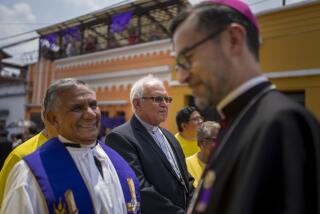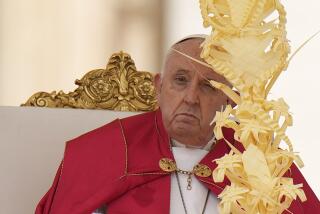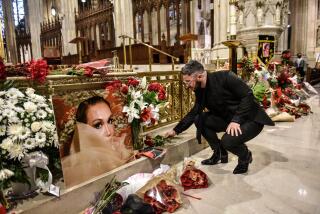Pope Beatifies Mother Teresa Before Throng of Rich, Poor
VATICAN CITY — Royalty prayed alongside the poor, and Indian dancers shared the stage with the world’s most eminent prelates, as Pope John Paul II on Sunday beatified Mother Teresa of Calcutta, giving the famous nun an elite status one step short of sainthood just six years after her death.
Before an enormous audience that spilled out of St. Peter’s Square down the broad Via della Conciliazione to the Tiber River, the woman already called the “Saint of the Gutters” for her work with the sick, dying and unwanted, was named “blessed” by the frail, sick pope.
He praised her as an icon of the good Samaritan, saying her goodness derived from having “chosen to be not just the least, but to be the servant of the least.”
The ceremony chimed with song and the sounds of many languages, and sparkled with colors of costumes, faces, flags and flowers. It took place under sunny, blue skies despite fierce rainstorms overnight.
But the pope, who greatly admires Mother Teresa, was unable to read his homily, or sermon, in her honor -- the first time this physically deteriorating pontiff has not pronounced any part of a major papal address.
For many of the tens of thousands of pilgrims who crowded into Vatican City, beatification was merely a formality.
Some officials estimated the crowd at 300,000, one of the largest audiences at the Vatican ever.
“Saint or no saint, she was a uniquely good woman,” said Jacqueline Munoz, 33, of Lima, Peru. “A noble, kind-hearted woman who did everything for the poor and sick. It doesn’t matter what title she has.”
Ranee Clayton, 63, a psychotherapist who traveled from Corpus Christi, Texas, to see the pope beatify Mother Teresa, said the wispy nun cured souls as well as bodies.
“In the field [of psychotherapy] you hear all kinds of bad stuff; she was a dose of good stuff,” Clayton said.
The ceremony underscored two elements the pope considers especially important: the multiethnic, international flavor of the church, and attention to the poor.
The Roman Catholic Church is no longer dominated by white Western Europe, and John Paul has sought to illustrate this by naming hundreds of saints and “blesseds” from all parts of the world. In the College of Cardinals, most of which was also named by this pope, roughly 38% of the members are African, Latin American and Asian.
Diversity and multiculturalism were in full view Sunday as regional rituals were incorporated into an ancient Catholic rite, reflecting Mother Teresa’s worldwide fame and following.
In a procession before the pope, known as the offertory, Indian women in golden saris held aloft incense, trays of petals and water bowls with floating candles as they drifted onto the stage, past cardinals in scarlet and bishops in purple. Prayers were read in half a dozen or more languages, including Bengali, Albanian and Arabic.
In front-row seats were a queen, princes, presidents and diplomats. Seated next to them were 2,000 homeless people, their attendance meant as homage to Mother Teresa’s work. After the ceremony, members of Mother Teresa’s order celebrated by inviting the homeless to a hot lunch.
Among the official guests were delegations from Albania and Macedonia, including Muslims and Orthodox Christians. Mother Teresa was born in 1910 to an ethnic Albanian mother in the Balkan city of Skopje, which today is the capital of Macedonia. The two groups, fierce ethnic rivals in the Balkans, have been spatting over who has greater claim to the nun.
“We are very proud to have the same nationality,” said Albanian pilgrim Albana Prendi, 25. “We, more than anybody else, are like her children.”
Prendi was in one of several knots of Albanians waving their distinctive national flag, solid red with a black, double-headed eagle.
In his homily, read by cardinals, the pope said Mother Teresa had taken the “road that Jesus Christ walked” by seeking out “an itinerary of love and service” and self-sacrifice on behalf of the downtrodden.
“As a real mother to the poor, she bent down to those suffering various forms of poverty,” he said. “Her life was a radical living and a bold proclamation of the Gospel.”
Focusing on the poor is a theme John Paul has touched on recently. On Saturday, in a closed meeting, he exhorted the cardinals to “more incisive work” by following Teresa’s example “to highlight the face of the church that loves the poor, that is simple, that takes the side of the weakest in society.”
And in a major document he signed and released last week, he lamented the gulf between rich and poor and urged prelates to live simple lives.
“The Holy Father is holding her up as a model and saying that if we don’t reach out the way Jesus Christ did and the way Mother Teresa did, then we are missing the point,” Cardinal Roger Mahony, the archbishop of Los Angeles, said in an interview Sunday.
During the 2 1/2 hour Mass, John Paul was also presented with a “relic” of Mother Teresa, specifically a cotton swab soaked in her blood and encased in a wooden and glass box. In addition to the move toward sainthood, beatification makes public veneration permissible, and the relic will go on display this week in the basilica of St. John Lateran in Rome.
Although the pope’s sermon was an unusually personal recollection of the “courageous woman” he said he felt was so often at his side, he was unable to read a single word of it.
As his health fails, John Paul, who is 83 and suffers from Parkinson’s disease, arthritis and other ailments, has increasingly turned over the reading of portions of his homilies and speeches to aides. He normally reads the opening and closing passages. But on Sunday he didn’t read any of the speech, despite the importance he attached to the event.
“We are in fact watching the pope die,” John L. Allen, a Vatican expert, said on CNN.
He was referring to what has been a very visible, steady deterioration in the pope’s condition in recent months. This has been an especially taxing period: last Thursday he marked 25 years as pontiff and Tuesday he must preside over the installation of 31 new cardinals.
The pope was especially keen to be able to move Mother Teresa in line for sainthood before his own death. He waived the five-year waiting period usually required before launching a campaign for beatification after the candidate’s death. One miracle had to be authenticated by the Vatican for beatification, and now a second miracle must be documented for Teresa’s elevation to sainthood.
Mother Teresa, who died at 87, founded the Missionaries of Charity in 1950 with 12 nuns. It grew to more than 4,500 sisters, added a branch for priests and brothers, and has chapters in 133 countries.
Mother Teresa went on to win the Nobel Peace Prize in 1979. But she was also criticized. She advised people to accept their poverty and suffering rather than attempt to fight it. And many critics felt her adherence to conservative church teachings exacerbated poverty and disease because of doctrinal opposition to birth control and the use of condoms.
More to Read
Sign up for Essential California
The most important California stories and recommendations in your inbox every morning.
You may occasionally receive promotional content from the Los Angeles Times.











